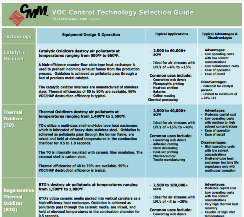There are thousands of industrial facilities around the world, all of which contribute to producing billions of consumer products. While these products may be extremely helpful, their production also puts a huge amount of stress on the environment and our health.
For this reason, the reduction of air pollution has become one of the hottest debate topics in the last 60 years. This article will talk about the different ways that factories and other industrial operations can reduce air pollution and destroy these compounds before they enter our atmosphere.
Common airborne pollutants generated by industrial operations
There are hundreds of different air pollutants that can be found in any given part of the world. However, the most dangerous emissions generated by industrial operations can be divided into three categories. These are:
VOCs
Volatile organic compounds, known as VOCs, are airborne pollutants that may cause both short and long-term health conditions in humans. These organic chemicals can originate from a variety of operations, with two of the most common being paint and adhesive manufacturing.
HAPs
Hazardous air pollutants are chemicals that are suspected or known to cause grave health complications. These include cancer, autoimmune diseases, nervous system conditions, respiratory complications, and many more.
Solid Particulate Matter
Solid particulate matter, simply referred to as PM, is a group used to describe airborne pollutants like dirt, debris, and smoke. As the name indicates, particulate matter can be made up of tiny fragments of virtually anything – from organic residue to synthetic compounds and micro-pollutants.
How to reduce air pollution from factories
Paint manufacturing facilities and other operations need to meet specific EPA requirements in order to stay open. At the same time, many factory managers and company owners focus on reducing air pollution because they are aware of the potential negative impact it may have.
The two most common ways companies can reduce their air pollution emissions are:
Optimizing the factory’s operations
Greener, more energy-efficient operations tend to reduce the amount of pollution a factory generates. Companies can optimize different parts of their operation to save energy, thus reducing the facility’s overall emissions.
Destroying pollutants before they enter the atmosphere
Factory operators can also employ abatement mechanisms that help destroy VOCs, HAPs, and other pollutants before they enter the environment. Different abatement techniques are efficient for specific types of pollutants, so you need to evaluate your operation to find the ideal technique. Four of the most commonly used abatement techniques include:
Regenerative Thermal Oxidizer
Known as RTOs, regenerative thermal oxidizers employ high temperatures to destroy pollutants before they are released into the environment. The energy of the actual industrial operation is used in the abatement process whenever possible, which involves a network of high-efficiency heat exchangers.
Recuperative Thermal Oxidizer
Recuperative thermal oxidizers also referred to as TOs, rely on high temperatures and heavy-duty steel heat exchangers to destroy VOCs before they enter the atmosphere.
Catalytic Oxidizer
Catalytic oxidizers use a combination of chemical catalysts and high temperatures to break down pollutants into harmless compounds.
Oxidizers with Rotary Concentrators
Rotary concentrators combined with oxidizers are ideal for chemical processing, surface coating, and wood finishing facilities, just to name a few.
Contact the CMM Group Today
Get in touch with The CMM Group and our team of experienced engineers will be happy to help you out. Feel free to give us a call or fill out our online contact form today!






